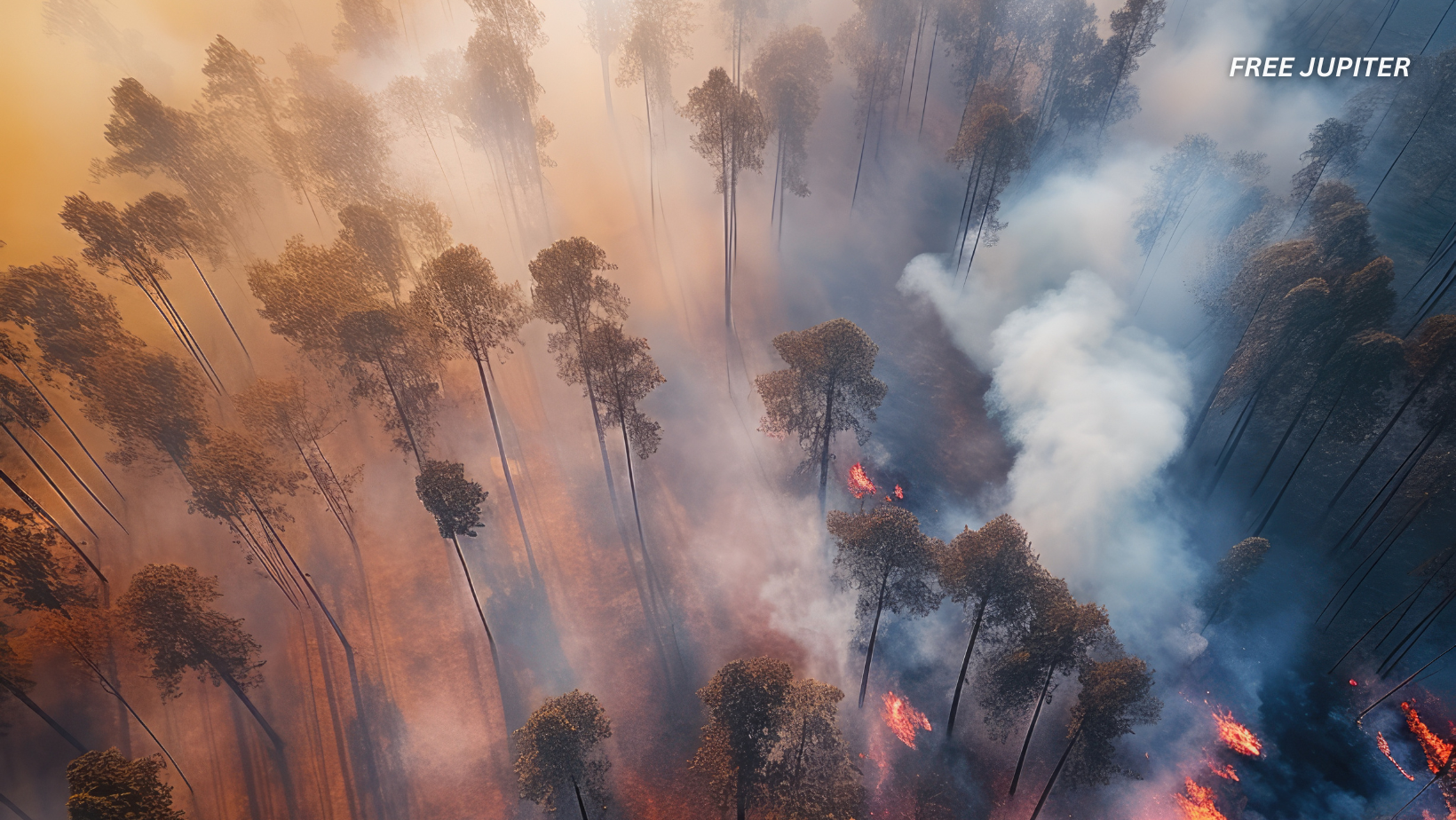Canada is currently grappling with a severe wildfire crisis, with over 200 active fires consuming approximately 10,000 square miles (26,000 square kilometers) since the start of the year, according to the Canadian Interagency Forest Fire Centre as of early June 2025. This widespread burning has sent plumes of smoke drifting far beyond Canadian borders, severely impacting air quality across vast regions of the United States, reaching as far south as Florida, as reported by the National Oceanic and Atmospheric Administration (NOAA).
With climate change intensifying and prolonging wildfire seasons globally, it becomes crucial to deepen our understanding of the health risks posed by wildfire smoke, which recent studies reveal extend well beyond the lungs.
The Lingering Toll of Wildfire Smoke on Health
Research led by Yaguang Wei, an environmental medicine expert at Mount Sinai’s Icahn School of Medicine, underscores the lasting harm wildfire smoke can inflict on the body. Published in the journal Epidemiology in May 2025, Wei’s study found that exposure to wildfire smoke can damage the lungs and cardiovascular system for up to three months after the fire subsides. This medium-term exposure correlates with heightened risks of heart disease, stroke, hypertension, pneumonia, chronic lung conditions, and asthma. Wei emphasized that even short-term exposure to smoke from smaller fires, lasting just a few days, can have long-lasting health consequences.
What Exactly Is in Wildfire Smoke?
Wildfire smoke is a complex cocktail of gases, water vapor, air pollutants, and fine particulate matter known as PM2.5—particles small enough to penetrate deep into the lungs. The Environmental Protection Agency (EPA) highlights that wildfire smoke contains toxic substances such as polycyclic aromatic hydrocarbons (PAHs) and volatile organic compounds (VOCs), some of which are carcinogenic. Intriguingly, recent research has also detected microbial and fungal pathogens within wildfire smoke.
A 2021 study published in the ISME Journal found that about 80% of microbes present in wildfire smoke samples remained viable, despite the extreme heat of the fires. Experts like George Thompson, a medicine professor at the University of California, Davis, explain that these microbes are drawn into the smoke from surrounding soil and vegetation as fires consume the landscape. While most of these microorganisms do not pose infection risks to healthy individuals, they may threaten those with compromised immune systems, such as chemotherapy patients or trauma survivors.
Adding to concerns, a 2023 study in The Lancet Planetary Health linked California wildfires to an 18% to 22% increase in invasive fungal infections like valley fever, suggesting that wildfire smoke might elevate infection risks even among the general public. Though based on hospital data, this research calls for further investigation to confirm these findings.
Read more: Experts Reveal If Going To The Bathroom ‘Just in Case’ Is Bad For You Or Not
The Brain Under Siege
Among the many harmful components of wildfire smoke, PM2.5 particles stand out as particularly dangerous. Their tiny size allows them to infiltrate the deepest parts of the lungs and enter the bloodstream, where they can cause inflammation and oxidative stress that affect multiple organs, including the brain. Studies have increasingly connected wildfire smoke exposure to neurological conditions such as stroke and dementia.
A significant 2024 study published in JAMA Neurology examined health records of over 1.2 million older adults in Southern California. It revealed that long-term exposure to wildfire-related PM2.5 raised the risk of dementia by 18% for every 1 microgram per cubic meter increase in the three-year average of wildfire smoke particles. This risk was notably higher than the 1% increase associated with PM2.5 from other pollution sources. Holly Elser, the study’s lead author, expressed surprise at the strong link between wildfire smoke and dementia compared to other particulate matter, highlighting the unique dangers posed by wildfire emissions.
Mental Health Impacts of Smoke Exposure
Beyond physical health, wildfire smoke also appears to influence mental well-being. An April 2025 study published in JAMA Network Open analyzed mental health emergency visits during California’s record wildfire season in 2022. It found a significant rise in such visits for up to a week following exposure to wildfire smoke, suggesting that the smoke itself may exacerbate conditions like depression, anxiety, and mood disorders, independent of the trauma caused by the fires themselves. Kari Nadeau, a physician-scientist at Harvard’s School of Public Health and co-author of the study, noted that smoke exposure could directly worsen mental health outcomes.
The Complexity of Assessing Wildfire Smoke Effects
Despite growing evidence of the multifaceted harm caused by wildfire smoke, many questions remain unanswered. Angela Yao, a senior scientist at the B.C. Centre for Disease Control’s Environmental Health Services, points out the challenge of separating the health effects of smoke from those of the fires themselves. Future research will need to untangle these overlapping impacts to better inform public health strategies. Nonetheless, current findings already justify urgent action to mitigate exposure and protect vulnerable populations.
Read more: NASA Captures Stunning Image Of Massive Mars Volcano Piercing Through The Ice Cloud Belt
Protecting Yourself from Wildfire Smoke
Experts recommend several practical measures to reduce the health risks associated with wildfire smoke. Limiting outdoor activities during smoky conditions is crucial, as heavier breathing increases the amount of smoke inhaled. When going outside is unavoidable, wearing high-quality masks such as N95 or P100 respirators can significantly reduce particle inhalation.
Keeping indoor air clean is equally important. Closing windows and doors helps prevent smoke infiltration, and ensuring that heating, ventilation, and air conditioning (HVAC) systems are functioning properly can improve indoor air quality. For those without central HVAC, portable air purifiers equipped with HEPA filters or DIY air filtration units made from box fans and furnace filters can be effective alternatives.
The Broader Environmental and Social Context
The wildfire crisis in Canada is not just an environmental or health issue but also a social equity concern. Indigenous communities, who have long practiced controlled burns to manage forest fuel loads and reduce wildfire severity, are disproportionately affected by these large-scale fires and the resulting smoke. Traditional burning practices, which have only recently begun to be reintroduced, offer a potential path to mitigating future wildfire impacts.
Furthermore, decades of industrial activity have left Canadian soils and waterways contaminated with toxic metals such as lead and mercury. These pollutants can become airborne during wildfires, compounding the toxicity of the smoke. As wildfire smoke drifts into the United States and even across the Atlantic to Europe, it undergoes chemical transformations that produce ozone, a harmful pollutant that exacerbates respiratory conditions like asthma.
Read more: California’s Yurok Tribe Wins Ancestral Lands Back That Were Taken Over 120 Years Ago
Conclusion
The ongoing wildfires across Canada and their far-reaching smoke plumes reveal a complex and alarming public health challenge. Wildfire smoke is far more than a mere nuisance; it carries a potent mix of toxic chemicals, infectious agents, and fine particles that can harm the lungs, heart, brain, and mental health. As climate change fuels longer and more intense wildfire seasons, understanding and mitigating these risks becomes ever more urgent. Taking proactive steps to reduce exposure and supporting research into the full spectrum of health effects are critical as communities worldwide face this growing threat.










